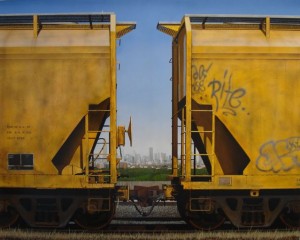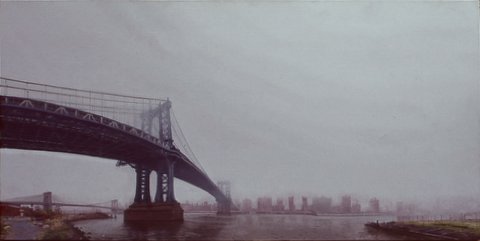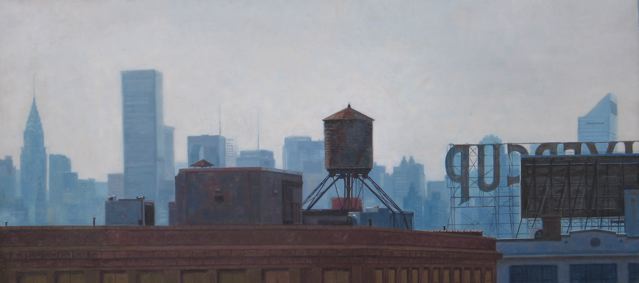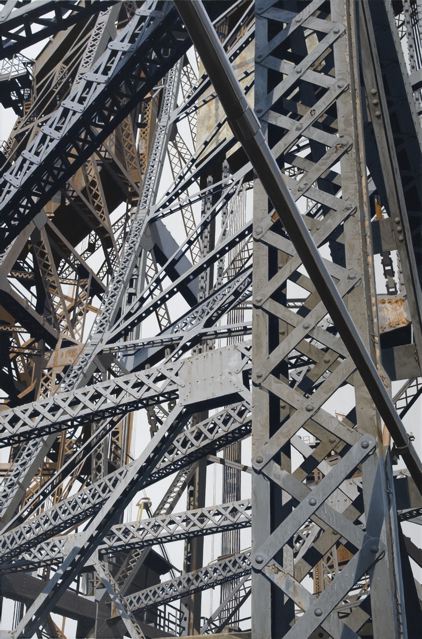POPULAR APPRECIATION OF LANDSCAPE hinges on the romance of a good view. By contrast, the scenery of urban infrastructures—the natural setting of urban artists—is more challenging.
Even middling painters can produce attractive pictures of beautiful places. It takes more robust sensibilities to seek order and grace in city sights readily ignored. Easy pleasure is not available. Viewers are on their own to discover the emotional keynote to scenes that have nothing picturesque about them.

New York Moments showcases the urban landscape in a group show that includes many of the gallery’s best artists and several welcome guests. Here are recent cityscapes by 31 painters whose interests range from iconic New York sites to Manhattan side streets and outer borough byways. So much intelligent work is here that there is not enough column space to give it its due.

Let me start with Elizabeth O’Reilly. Her collages, cut from papers washed in watercolor, are deft, graceful and satisfying. The scissored clarity of her view of the 9th Street bridge over the Gowanus demonstrates the discipline knifed edges impose on a painterly imagination. Both contour and color are pitch-perfect. Equal, if moodier, magic occurs in Tim Saternow’s Cortlandt Alley, Rain. He handles the play of light on the wet streets of a narrow, tenement corridor—a surviving back alley on the edge of Chinatown—with great skill and an eye for enlivening detail: the lattice of fire escapes, a flash of color where light hits red brick.

Ephraim Rubenstein looks at the city, across the East River, from Long Island City. Silvercup I, graphically striking but elegiac in tone, surveys a subdued Manhattan skyline from a high vantage point behind the old Silvercup Bakery. The letters of the original neon sign, seen from the back and silhouetted against the sky, are a subtle tribute to the beauty of the borough’s defunct industrial buildings. Nicholas Evans-Cato advances on the Manhattan Bridge from an acute angle of vision that exaggerates the sweep and span of the structure. It is a majestic view that leaps past the taken-for-granted reality of the bridge to the sheer wonder of a century-old civil engineering landmark.

Where Evans-Cato softens his structure in atmospheric conditions, Roland Kulla takes a more clinical approach to the supports for the Jersey PATH train. He records the beams, bolts, bearings, girders and abutments that rise in a crescendo of structural agility. In terms of visual design, the motif is surprisingly beautiful. A flush of sunlight heats a stanchion of the Brooklyn Bridge in Stephen Magsig’s adroit depiction of the brickwork and its reflection on the river below.

One lovely surprise is a medley of inimate panels of tree-shaded streets by Reñat Iglesias. A young Basque, he has studied largely abroad— in Bilbao, Pamploma, Barcelona, Mexico and England before coming to the Art Students League. His work is a delectable tribute to the atelier system that emphasizes sensibility and craft over fashion. Lastly, Santana’s handsome rendering of the Statue of Liberty avoids cliché by emphasizing mass and contour, omitting too-familiar detail. In all, a fine exhibition that column space does not do justice to.
New York Moments at George Billis Gallery, 555 West 25th Street, 212-645-2621.
This review appeared first in CityArts, July 15, 2010.
© 2010 Maureen Mullarkey


